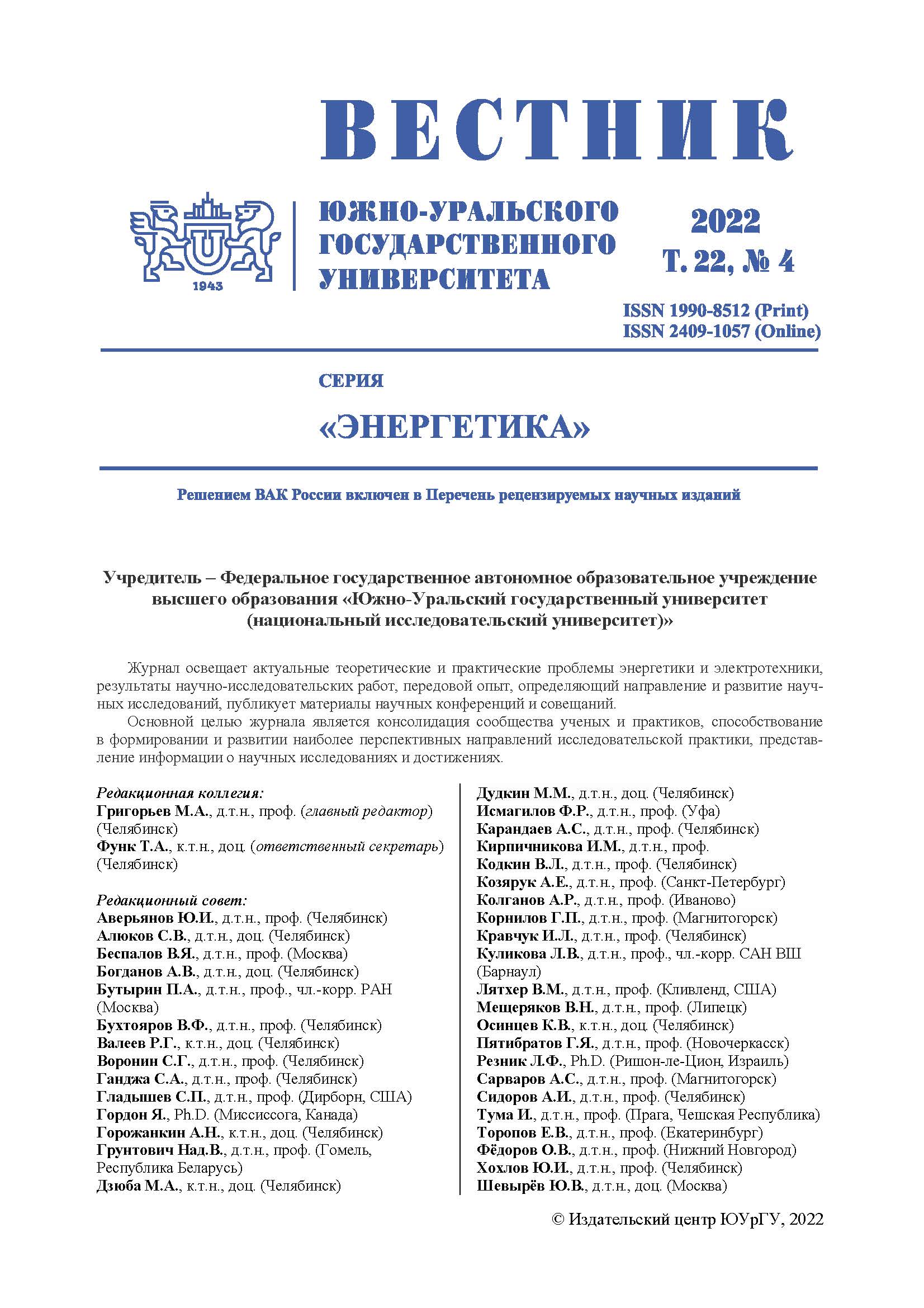A MATHEMATICAL MODEL OF A POWER CABLE CURRENT-CONDUCTING CORE HEATING TAKING INTO ACCOUNT ELECTROTHERMAL PROCESSES IN CABLE LINE DIGITAL TWINS
DOI:
https://doi.org/10.14529/power220401Keywords:
digital twin, cable line, heating temperature, mathematical electrothermal model, dynamic thermal resistanceAbstract
This article deals with the implementation of diagnostics and monitoring of the current-conducting part and insulation state of high-voltage cable lines in real time using digital twins. The problems of thermal accounting and the fea-tures of modeling electrothermal heating processes in power cables are determined. A mathematical electrothermal model of a power cable for a cable line digital twin is proposed, based on the decomposition of its dynamic thermal resistance in-to the sum of exponential components, which makes it possible to calculate the instantaneous values of the heating temper-ature of a current-conducting cable core in real time with insignificant amounts of calculations on the discretization interval of the calculation. The results of calculation using the heating temperature model for a single-core power cable with a three-phase short circuit in the network are presented.
Downloads
References
Царев М.В., Андреев Ю.С. Цифровые двойники в промышленности: история развития, классифика-ция, технологии, сценарии использования // Известия высших учебных заведений. Приборостроение. 2021. № 64 (7). С. 517–531. DOI: 10.17586/0021-3454-2021-64-7-517-531
Uhlemann T. H-J., Steinhilper C.L., Steinhilper R. The Digital Twin: Realizing the Cyber-Physical Produc-tion System for Industry 4.0 // Procedia CIRP. 2017. Vol. 61. P. 335–340. DOI: 10.1016/j. procir.2016.11.152
Boschert S., Rosen R. Digital Twin – The Simulation Aspect // Mechatronic Futures. Springer International Publishing. 2016. P. 59–74. DOI: 10.1007/978-3- 319-32156-1_5
Tao F., Zhang J. Digital twin workshop: a new paradigm for future workshop // Computer Integrated Ma-nufacturing Systems. 2017. Vol. 23. P. 1141–1153. DOI: 10.13196/j.cims.2017.01.001
Zheng Y., Yang S., Cheng H. An application framework of digital twin and its case study // Journal of Am-bient Intelligence and Humanized Computing. 2018. Vol. 10. P. 1141–1153. DOI: 10.1007/s12652-018-0911-3
Bolton R.N. Customer experience challenges: bringing together digital, physical and social realms // Journal of Service Management. 2018. Vol. 29. P. 776–808. DOI: 10.1108/JOSM-04-2018-0113
Khalyasma A., Eroshenko S., Shatunova D. et al. Digital twin technology as an instrument for increasing electrical equipment reliability // 4th International Conference on Reliability Engineering (ICRE 2019). 2019. Vol. 836. P. 1–5. DOI: 10.1088/1757-899X/836/1/012005
Васильев А.Н., Тархов Д.А., Малыхина Г.Ф. Методы создания цифровых двойников на основе нейросетевого моделирования // Современные информационные технологии и ИТ-образование. 2018. Т. 14, № 3. С. 521–532. DOI: 10.25559/SITITO.14.201803.521-532
Pang B., Zhu B., Wang S., Li R. On-line monitoring method for long distance power cable // IEEE Tran-sactions on Dielectrics and Electrical Insulation. 2016. Vol. 23. P. 70–76. DOI: 10.1109/TDEI.2015.004995
Пономарев Н. В. Анализ методов диагностики состояния силовых высоковольтных кабельных ли-ний // Вестник Кузбасского государственного технического университета. 2012. № 5 (93). С. 68–71.
Опыт применения термического анализа для изучения теплопроводности полимерных материалов для кабельных изделий / А.Н. Горобец, А.А. Крючков, В.Л. Овсиенко и др. // Кабели и провода. 2013. № 5 (342). С. 16–18.
ГОСТ Р МЭК 60287-1-3–2009. Кабели электрические. Расчет номинальной токовой нагрузки. Часть 1-3. Уравнения для расчета номинальной токовой нагрузки (100 % – коэффициент нагрузки) и рас-чет потерь. Распределение тока между одножильными кабелями, расположенными параллельно, и расчет потерь, обусловленных циркулирующими токами. М.: Стандартинформ, 2010. 20 с.
ГОСТ Р МЭК 60287-2-1–2009. Кабели электрические. Расчет номинальной токовой нагрузки. Часть 2-1. Тепловое сопротивление. Расчет теплового сопротивления. М.: Стандартинформ, 2010. 36 с.
Neher J.H., McGtath M.H. The Calculation of the Temperature Rise and Load Capability of Cable Sys-tems // AIEE Transactions. 1957. Vol. 76. P. 755–772. DOI: 10.1109/AIEEPAS.1957.4499653
Kolesnikov I.E., Korzhov A.V., Gorshkov K.E. A Digital Model for Evaluating the Thermal Behavior of Power Cable Couplings // Proceedings 2020 Global Smart Industry Conference (GloSIC). 2020. P. 309–314. DOI: 10.1109/GloSIC50886.2020.9267881
Van Wormer F.C. An Improved Approximate Technique for Calculating Cable Temperature Transients // Trans. Amer. Inst. Elect. Engrs. 1955. Vol. 74, part 3. P. 277–280. DOI: 10.1109/AIEEPAS.1955.4499079
Расчет температурных полей и токовых нагрузок кабелей в ANSYS / Л.А. Ковригин, Н.А. Белкин, Р.А. Биянов и др. // Кабель-news. 2009. № 4. С. 91–95.
Построение модели цифрового двойника подземного электрического кабеля: тепловая часть зада-чи / Ю.Д. Кутумов, В.Е. Мизонов, А.И. Тихонов, Т.Ю. Шадрикова // Вестник Ивановского государственного энергетического университета. 2021. № 3. C. 59–65. DOI: 10.17588/2072-2672.2021.3.059-065
Свидетельство о государственной регистрации программы для ЭВМ № 2012617384. Zth-Appro-ximation / К.Е. Горшков, М.Е. Гольдштейн. Заявл. 22.06.2012; зарег. 16.08.2012; опубл. 20.12.2012; Бюл. Роспатента RU ОБПБТ № 4 (81). С. 333.









